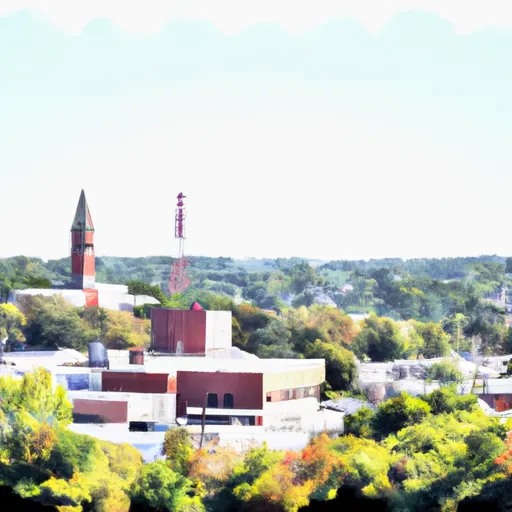-
 Snoflo Premium
Snoflo Premium
Get unlimited access to all our content
With no Ad interruptions! - Start Your Free Trial Login with existing account
Rochdale
Eden Index
Climate
8.6
•
Recreation
2.8
•
Community
4.2
•
Safeguard
5.5/10

Rochdale, Massachusetts is a small town located in Worcester County. It experiences a humid continental climate, characterized by hot summers and cold winters. Average high temperatures in summer range from 80°F (27°C) to 85°F (29°C), while winter temperatures average between 30°F (-1°C) and 40°F (4°C). The town receives moderate rainfall throughout the year, with July being the wettest month.
Rochdale is surrounded by several water bodies, including the Quinebaug River, which flows through the town. This river and its tributaries provide hydrological constituents to the area, supporting diverse aquatic ecosystems. Additionally, Rochdale is situated near several lakes and ponds, such as Glen Echo Lake and Lake Lashaway, offering opportunities for fishing, boating, and water-based activities.
Outdoor recreation enthusiasts can explore various options in Rochdale. The town boasts several parks and trails, such as the Rochdale Park and the Heritage Path, providing opportunities for hiking, biking, and picnicking. Additionally, the nearby Leicester Country Club offers a golf course for those who enjoy the sport. Rochdale's natural surroundings and accessible water resources make it an ideal location for outdoor activities and a peaceful retreat for nature enthusiasts.
What is the Eden Index?
The Snoflo Eden Index serves as a comprehensive rating system for regions, evaluating their desirability through a holistic assessment of climate health, outdoor recreation opportunities, and natural disaster risk, acknowledging the profound impact of these factors on livability and well-being.
Climate Health Indicator (CHI): 8.6
Rochdale receives approximately
1271mm of rain per year,
with humidity levels near 75%
and air temperatures averaging around
9°C.
Rochdale has a plant hardyness factor of
6, meaning
plants and agriculture in this region thrive during a short period during spring and early summer. Most
plants will die off during the colder winter months.
By considering the ideal temperature range, reliable water supplies, clean air, and stable seasonal rain or snowpacks, the Climate Health Indicator (CHI) underscores the significance of a healthy climate as the foundation for quality living.
A healthy climate is paramount for ensuring a high quality of life and livability in a region, fostering both physical well-being and environmental harmony. This can be characterized by ideal temperatures, reliable access to water supplies, clean air, and consistent seasonal rain or snowpacks.
Weather Forecast
Streamflow Conditions
Connecticut Coastal
Area Rivers
Connecticut Coastal
Snowpack Depths
Connecticut Coastal
Reservoir Storage Capacity
Connecticut Coastal
Groundwater Levels
Recreational Opportunity Index (ROI): 2.8
The Recreational Opportunity Index (ROI) recognizes the value of outdoor recreational options, such as parks, hiking trails, camping sites, and fishing spots, while acknowledging that climate plays a pivotal role in ensuring the comfort and consistency of these experiences.
Access to outdoor recreational opportunities, encompassing activities such as parks, hiking, camping, and fishing, is crucial for overall well-being, and the climate plays a pivotal role in enabling and enhancing these experiences, ensuring that individuals can engage in nature-based activities comfortably and consistently.
Camping Areas
| Campground | Campsites | Reservations | Toilets | Showers | Elevation |
|---|---|---|---|---|---|
| Otter River State Forest | 85 | 864 ft | |||
| Lake Dennison State Park | 150 | 829 ft |
Nearby Fishing
Nearby Ski Areas
Catastrophe Safeguard Index (CSI):
The Catastrophe Safeguard Index (CSI) recognizes that natural disaster risk, encompassing floods, fires, hurricanes, and tornadoes, can drastically affect safety and the overall appeal of an area.
The level of natural disaster risk in a region significantly affects safety and the overall livability, with climate change amplifying these risks by potentially increasing the frequency and intensity of events like floods, fires, hurricanes, and tornadoes, thereby posing substantial challenges to community resilience and well-being.
Community Resilience Indicator (CRI): 4.2
The Community Resilience Indicator (CRI) recognizes that education, healthcare, and socioeconomics are crucial to the well-being of a region. The CRI acknowledges the profound impact of these elements on residents' overall quality of life. By evaluating educational resources, healthcare accessibility, and economic inclusivity, the index captures the essential aspects that contribute to a thriving community, fostering resident satisfaction, equity, and social cohesion.

